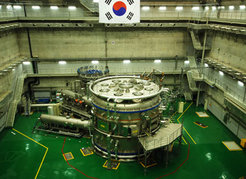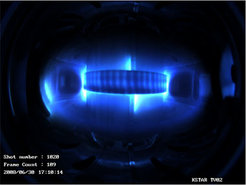First plasma in Korea's KSTAR fusion experiment
Superconducting Magnet coils / reparation for ITER / four new fusion devices in Asia

The objective of fusion research is to derive energy like the sun from fusion of atomic nuclei. To ignite the fusion fire in a power plant one has to succeed in confining the fuel, an ionised low-density gas called plasma, thermally insulated in magnetic fields and heating it to temperatures of over 100 million degrees.
Besides Korea’s participation in the ITER international experimental reactor, the new KSTAR fusion project forms the core of its fusion programme. As the name reveals, KSTAR (Korean Superconducting Tokamak Advanced Research) is concerned with today’s most topical subject in fusion research world-wide, so-called Advanced Scenarios: Planned as a medium-sized device of the tokamak type, KSTAR is to contribute with new modes of operation to paving the way to a tokamak with continuous operation. With a volume of 16 cubic metres, the plasma is comparable to that of ASDEX Upgrade at Max Planck Institute of Plasma Physics in Garching, Germany’s largest fusion device. It is shaped like the – much bigger – plasma of the ITER fusion experiment, construction of which is to begin next year at Cadarache, France, as an international cooperation. Unlike ASDEX Upgrade, which still operates with normally conducting copper coils, KSTAR, like ITER, is equipped with superconducting niobium-tin magnet coils. This will allow the device later to attain pulse lengths of up to 300 seconds.
KSTAR started operation stepwise in February. Fist the vacuum and density of the plasma vessel were tested, then the superconducting magnets were cooled to a low temperature of 4.5 Kelvin, close to absolute zero, and finally from mid-June the first plasmas were produced. This smooth start to plasma production, say the Korean researchers, has enabled them to accomplish the fist step towards world-class fusion research.

The coming years of research with KSTAR will therefore contribute, as Korea’s Ministry of Science are convinced, to providing “the world, facing serious energy problems, with a clean energy source, named Fusion”. Comparable commitment is also coming from the other ITER partners in Asia – China, India and Japan: The EAST (Experimental Advanced Superconducting Tokamak) experiment is enabling China to tackle highly topical research problems; SST-1 (Steady State Superconducting Tokamak) is now being built in India; and in Japan the JT-60 Upgrade device is about to be converted and equipped with superconducting magnet coils.
Isabella Milch

